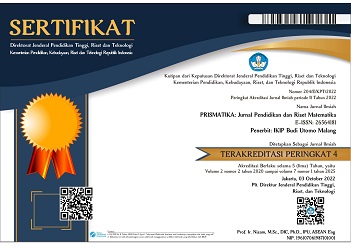ANALISIS PROBLEMATIKA PEMBELAJARAN MATEMATIKA DI SEKOLAH MENENGAH PERTAMA DAN SOLUSI ALTERNATIFNYA
Abstract
The study was conducted aimed at finding out the problems in learning mathematics in junior high schools, especially at SMP Muhammadiyah 8 Batu with alternative solutions. The method used in this study is a qualitative research approach. The research subjects were two students from class IX-1 and IX-6 each representing students from homogeneous and heterogeneous classes, as well as two math teachers at SMP Muhammadiyah 8 Batu who each taught in homogeneous and heterogeneous classes . Analysis of the data used in this study is analysis of observations, questionnaire results and interview transcripts. Based on the results of the research, it was found that the problem of mathematics learning in SMP Muhammadiyah 8 Batu is 1) poor mathematical mastery; 2) learning motivation that is not good; 3) the use of instructional media and 4) the application of learning methods. An alternative solution to these problems is the need for scaffolding when students experience difficulties, there is a personal approach to students, it is necessary to use more interesting learning media, for example macromedia flash and educational games, the application of learning methods tailored to the characteristics of good students for homogeneous and heterogeneous classes.
References
Mind Mapping Terhadap Prestasi Belajar Matematika Siswa Kelas VII
Smp Tunas Baru Jin-Seung Batam Tahun Ajaran 2014/2015.
JurnalPythagoras 5(1): 32-37 ISSN 2085-9996.
Asnawir & Usman B. (2002). Media Pembelajaran. Jakarta : Ciputat Press.
Damaningsih, E. N. (2016). Dampak Strategi Pembelajaran dan Kemandirian
Peserta didik terhadap Hasil Belaja Matematika SMP Materi Himpunan.
NaskahPublikasi Ilmiah Universitas Muhammadiyah Surakarta.
Dumont, J. J. (1994). Leerstoornissen. Deel 1: Theorie en Model [learning
Disabilities. Part 1: Theory and Model]. Rotterdam: Lemniscaat.
Denburg, N.L. & Tranel, D. (2003). Acalculia and disturbances of the body
schema. In K.M. Heilman & E. Valenstein (Eds.),Clinical Neuropsychology
(4th ed.). (pp. 161-184). New York: Oxford University Press.
Hamid, S. (2011). Metode Edutrainment. Jojakarta: Diva Press.
Hikmawati, dkk. (2013). Pengaruh Penggunaan Media Pembelajaran Dan
Gaya Kognitif Terhadap Hasil Belajar Matematika Siswa Kelas VIII
Madrasah Tsanawiyah. Tekno-Pedagog.i Vol. 3 No. 2: 1-11, ISSN 2088-
205X.
Hirtanto, dkk. (2015). Eksperimentasi Pembelajaran Matematika
Menggunakan Media Komputer pada Materi Pokok Persamaan Garis
Lurus Ditinjau dari Motivasi Belajar Siswa Kelas VIII SMP Surakarta
Tahun Ajaran 2011/2012. Jurnal Elektronik Pembelajaran Matematika
Vol. 3, No. 8 ISSN 2339-1685.
Kamphaus, R. W., dkk. (2000). Current Trends in Psychological Testing of
Children. Professional Psychology: Research and Practice, 31, 155-164.
Khatimah, K., Cholis S., & Hery S. (2017). Pemberian Scaffolding untuk
Mengatasi Hambatan Berpikir Siswa dalam Memecahkan Masalah
Aljabar. JKPM: Jurnal Kajian Pembelajaran Matematika, 1(1), 36-45.
Mazzocco M. M., & Myers G. F. (2003). Complexities in Identifying and
Defining Mathematics Learning Disability in the Primary School Age
Years. Annals of Dyslexia, 53: 218-253.
Raras Kartika Sari
Analisis Problematika Pembelajaran Matematika di Sekolah Menengah Pertama dan Solusi
Alternatifnya
Prismatika: Jurnal Pendidikan dan Riset Matematika Vol. 2 No. 1 (2019) 31
Misel, E. S. (2016). Penerapan Pendekatan Matematika Realistik Untuk
Meningkatkan Kemampuan Representasi Matematis Siswa. Didaktik , 10
(2), 27-36.
Mundla, L. (2012). The Assessment of Math Learning Difficulties in a Primary
Grade-4 Child with High Support Needs: Mixed Methods Approach.
International Electronic Journal of Elementary Education, 4(2), 347-366.
Novitasari, D. (2016). Pengaruh Penggunaan Multimedia Interaktif Terhadap
Kemampuan Pemahaman Konsep Matematis Siswa. Jurnal Fibonacci, 2
(2).
Podomi, P.A & Jailani. (2015). Pengaruh Pendekatan Analogi Personal
terhadap Prestasi, Penalaran, dan Kemandirian Siswa Materi Dimensi
Dua di SMK. Pythagoras: Jurnal Pendidikan Matematika, 10 (1), 61-70.
Sahudin, A. (2014). Implementasi Strategi Pembelajaran Discoveryuntuk
Meningkatkan Kemampuan Pemecahan Masalah Matematis dan
Motivasi Belajar Peserta didik SMA. Jurnal Pendidikan Unsika, 2 (1).
Steenbrugge, V. H., dkk. (2011). Mathematics Learning Difficulties in Primary
Education: Teachers’ Professional Knowledge and the Use of
Commercially Available Learning Packages. Publication in Educational
Studies.
Suandito, B. (2017). Bukti informal dalam Pembelajaran Matematika. Jurnal
Al-Jabar, 8 (1).
Sumatini, T. S. (2016). Peningkatan Kemampuan Pemecahan Masalah
Matematis Siswa Melalui Pembelajaran Berbasis Masalah. Jurnal
Pendidikan Matematika STKIP GaruT, 8 (3).
Toheri& Aziz, A. (2016). Pengaruh Penggunaan Media Belajar Audio Visual
terhadap Hasil Belajar Siswa Mata Pelajaran Matematika pada
Pembahasan Dimensi Tiga. Jurnal Pendidikan Matematika IAIN Syekh
Nurjati Cirebon.
Wasserman, N. H. (2010). Inside The Uteach Progam: Implications for
Research in Mathematics Teacher Education. Journal of Mathematics
Education at Teachers Collage, Spring Summer 2010 Volume 1.







.png)




